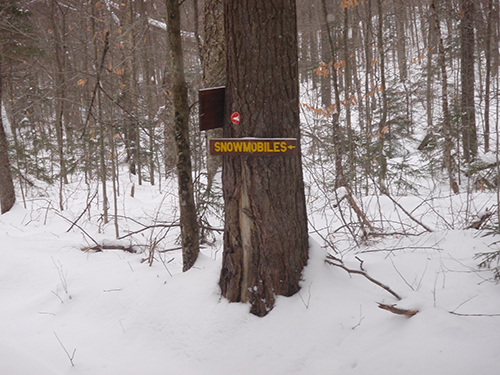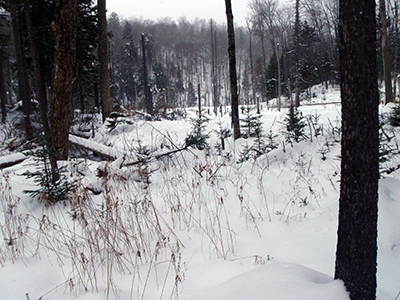
Adirondack Council is Pleased Adirondack Park Agency Reversed its Course on Snowmobile Trail Plan
Tuesday, May 19, 2015
By: William C. Janeway - Adirondack Council Executive Director
This blog first appeared in the Adirondack Almanack on May 18.
 Photo © Carl Heilman II/Wild Visions, Inc.
Photo © Carl Heilman II/Wild Visions, Inc.
At the Adirondack Park Agency (APA) on Thursday, the State Lands Committee approved sending to the full Board a recommendation that proposed Unit Management Plan (UMP) amendments should go to public comment. The plan favored a multi-use trail plan that included a series of new connector snowmobile trail segments. This recommendation was approved 3-1 over strenuous objections raised by the Committee Chairman Richard Booth.
On Friday, in response to concerns raised by the Adirondack Council and others, the APA commissioners voted unanimously to send to public review a proposed final plan that didn’t include a controversial trail segment that crosses the Hudson River at the Polaris Bridge.
The proposed Community Connector Multi-Use Trail Plan is now available for public review for 30 days to give people the opportunity to comment on the question of consistency between the Trail Plan and the Adirondack Park State Land Management Plan (SLMP). UMPs are site-specific plans that carry out the intent of the SLMP for each tract (unit) of Forest Preserve. The Dept. of Environmental Conservation (DEC) designs and proposes the UMPs. The APA administers the master plan and must agree that each unit plan complies with it.
The Adirondack Council wants to thank the Adirondack Park Agency and especially Commissioner Richard Booth and the staff, who made a strong case to the other 10 commissioners. They reaffirmed the arguments we made in our Monday letter to the APA, regarding the legally questionable process the agency was following by advancing a controversial new proposal from the DEC.
We also want to thank the Adirondack Mountain Club and others who expressed their objections to this controversial plan this week. This would have been a redundant and ecologically damaging trail. We don’t object to new trails, but we do object to trails -- and processes to consider them -- that are inconsistent with the law and harm the environment. And we have consistently opposed motorized or snowmobile use of the Polaris bridge crossing the Hudson, and a new snowmobile trail from that bridge through the Vanderwhacker Wild Forest.
The DEC plan includes a proposed final supplemental environmental impact statement (FSEIS) for the Community Connector (snowmobile) Trail Plan and related final UMP amendments. A prior draft that didn’t include the Polaris Bridge trail segment (Section 5) had been released and commented on. It did, however, include another problematic and controversial proposed new snowmobile route, east-west through the Vanderwhacker Wild Forest. When the current proposed final plan was released before the APA Commissioners met, a significant change was the removal of one controversial trail and the addition of another.
The new proposed controversial snowmobile trail would have connected to the existing Polaris Bridge spanning a state-designated Scenic River section of the Hudson River. The bridge was not previously open to the public. The trail was routed to run north through the Vanderwhacker Mountain Wild Forest, along and generally parallel to the Hudson River. There already exists an Indian Lake-Newcomb community connector to the west and there are additional options for connecting communities without crossing the Hudson River or traversing the Vanderwhacker.
 Advocates also argued during the week leading up to the APA meeting that the trail had a number of problems including the fact that it was redundant, inconsistent with the State Land Master Plan, and inconsistent with the State snowmobile guidance plan. Additional legal issues were detailed in the Adirondack Council’s letter of Monday May 11. The process by which the trail plan was being advanced also failed to consider the existing snowmobile trails found on the Cornell Road immediately to the west, and on the recently approved corridor between the Essex Chain Lakes Primitive Area and Hudson Gorge Wilderness Area.
Advocates also argued during the week leading up to the APA meeting that the trail had a number of problems including the fact that it was redundant, inconsistent with the State Land Master Plan, and inconsistent with the State snowmobile guidance plan. Additional legal issues were detailed in the Adirondack Council’s letter of Monday May 11. The process by which the trail plan was being advanced also failed to consider the existing snowmobile trails found on the Cornell Road immediately to the west, and on the recently approved corridor between the Essex Chain Lakes Primitive Area and Hudson Gorge Wilderness Area.
On Monday, the Council urged the APA to reconsider this request by the DEC. We objected that notification of the proposed Final UMPs for the Connector Trail Plan came at very short public notice – less than 7 days from when it first appeared in the agenda for the monthly meeting of the APA. The APA’s staff originally stated in a cover memo that the recommendation on the DEC’s request was compliant with the SLMP. However, concerns raised by Commissioner Booth and the comment letters alerted the APA’s staff that the significant changes between the draft and final versions would require additional review to ensure compliance with the SLMP.
The removal of the controversial Section 5 does not mean the end to the community connector trail between Newcomb, Indian Lake, Minerva and beyond. There are routes, which are ecologically less harmful, safer for riders and closer to existing travel corridors, where local businesses are located. The Polaris Bridge route would have been redundant.
We are pleased that the APA exercised good judgment and carefully reviewed the significant issues Commissioner Booth, the Council, and others raised. The only thing worse than making a mistake, is failing to correct that mistake. Although we have additional concerns over other issues remaining in the trail plan, we appreciate the action taken by the APA on Friday.
Would you like to comment on what you've read or viewed? We'd love to hear from you. Please click to send us a message.

William C. (Willie) Janeway returned to the Adirondacks to become the Executive Director and leader of the Adirondack Council in May 2013 after close to six years as the Regional Director for the State Department of Environmental Conservation Hudson Valley/Catskill Region. He brings to the Adirondack Council team a life-long passion and interest in the Adirondacks and nearly 30 years of experience as a professional conservationist, fundraiser, administrator, coalition builder and advocate for the environment.
After graduating from St. Lawrence University where he majored in economics and environmental studies, Willie lived in the Adirondacks for nine years while working for the Adirondack Mountain Club as the first Trails Coordinator, and North Country Director. Willie also served as the first Executive Director of the Albany Pine Bush Preserve Commission, Executive Director of the Hudson Valley Greenway, and State Director of Government Relations for The Nature Conservancy.
When not working Willie can be found outdoors. He is an Adirondack 46er, a year-round hiker and skier, a runner and a fisherman. He and his family share a camp in the Park. Willie and his wife Mary live in Keene.




